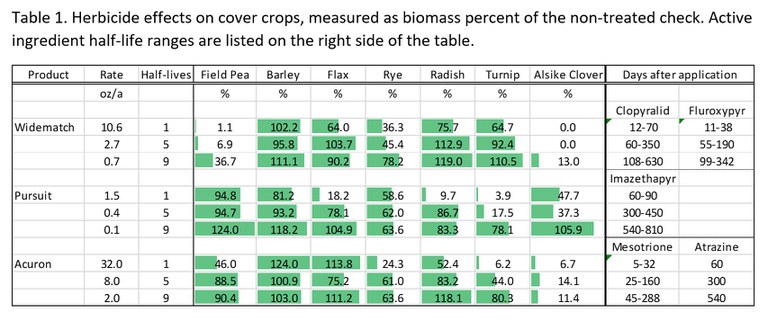Cover Crops: Living Their Best Half-life
Most will agree that cover crops do good things for soils. Cover crops also add to cropping system complexity and have costs associated with them. One of my recent research goals is to remove cover cropping barriers by better understanding potential reasons for failure. Dry conditions are one of the primary causes for lack of establishment and growth. Herbicide programs are another consideration that can cause establishment problems, but this issue can be navigated. Here are a few tools to get started:
This chart identifies the herbicide carryover risk associated with planting cover crops in the fall after spring wheat harvest (tested in North Dakota). https://www.ag.ndsu.edu/carringtonrec/documents/agronomyrd/docs-2017/2017-cover-crop-safety-following-wheat-herbicide-application/view. This information is also found in the ND Weed Control Guide. The 2021 ND Weed Control Guide will also contain a similar table for soybean herbicides.
Herbicide carryover is affected by several factors including rainfall, soil pH, soil organic matter content, soil biological activity, and soil texture. The rate of herbicide breakdown is measured through half-lives. If you remember from high school chemistry, a half-life is the amount of time it takes to degrade half of the product. For instance, if the herbicide has a half-life of 40 days and was applied at 10 oz/a, after 40 days there would be 5 oz/a left, at 2 half-lives (or 80 days) there would be 2.5 oz/a remaining. For most herbicides the rate of decay varies, sometimes wildly, depending on the factors listed above. It is useful to understand the half-life of an herbicide, how the herbicide is degraded, and how the speed of degradation may be affected in a specific field/environment. The herbicide carryover section of the ND Weed Control Guide is a good place to start (page 110 in the 2020 version).
We conducted a demonstration study in the greenhouse this winter to illustrate differences in half-lives. Table 1 lists the effect of micro-rates of herbicides to simulate different half-lives, and the effect those rates had on cover crops. This is listed as the percent of the non-treated check (so 0% means there was no growth). On the right-hand side, the half-life ranges of the products are listed. Many commercial herbicides contain more than one active ingredient. This means that a one product can have multiple half-lives. For instance, Widematch contains clopyralid and fluroxypyr, which degrade at different rates and affect different cover crop species. (Note that for simplicity, I only listed two of the four active ingredients in Acuron).

The key message is that when planning for cover crops, the herbicide program needs to be considered. Some herbicides can still suppress cover crop species more than a year later. However, conditions like high organic matter, high rainfall, and high biological activity reduce the effective persistence of herbicides by up to 500 days (I’m looking at you, clopyralid x clover!). In fact, microbial degradation is the primary driver of herbicide breakdown in all the products listed. This is complicated material, but now is the time to consider your options. Also consider that with the dry fall, herbicide carryover risk is starting out greater than normal.
Mike Ostlie, Ph.D.
Mike.Ostlie@ndsu.edu
Research Agronomist


